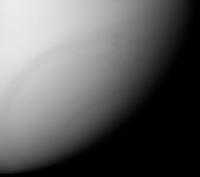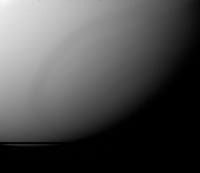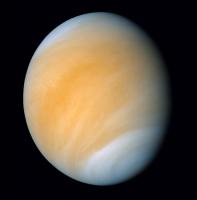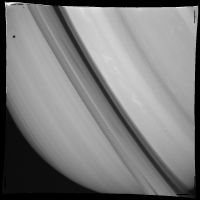Printable Version of Topic
Click here to view this topic in its original format
Unmanned Spaceflight.com _ Venus _ Venus Full Disk -mariner 10
Posted by: Malmer Sep 13 2005, 04:22 PM
Hi!
I have just finished compositing this large Venus panorama from Mariner 10.
I have tried to generate natural colors for the planet using orange and UV filters.
Raw frames: FDS 58870-59038
I used 78 frames in that range and then picked out a few other frames to fill in the gaps. There where about 5% missing data.
I did dark subtraction and flatfielding. for flatfields i used the venus images that looked flat enough.
Does anyone have any information on camera linearity and stuff?
I cant seem to find the calibration report; "MVM 73 TV Subsystem Calibration Report". if anyone has it, please let me have a look!
The full panorama is 4000*4000 pixels.
All processing is done in either floats or 16bit.
Take a look!
/mattias
http://www.syndicate.se/image/space/VENUS_HQ_MOSAIC.jpg
http://www.syndicate.se/image/space/VENUS_HQ_MOSAIC_Enhanced.jpg
http://www.syndicate.se/image/space/Venus_in_UV.jpg
Posted by: um3k Sep 13 2005, 04:43 PM
I don't know it for a fact, but I suspect the response is logarithmic.
EDIT: By the way, great pictures!
Posted by: Bob Shaw Sep 13 2005, 04:47 PM
Mattius:
Nice planet! I'll take two!
Seriously, nice mosaic...
Bob Shaw
Posted by: DarthVader Sep 13 2005, 05:23 PM
very nice indeed. Thanks for the work! ![]()
Posted by: 4th rock from the sun Sep 13 2005, 05:51 PM
Very nice images. Best Venus I've ever seen!
I like the colors but in my opinion using the Mariner 10 UV filter to create realistic images color isn't a good solution ![]() You can't see UV!
You can't see UV!
The best would be to use the Yellow bandpass (730-500um) , as you already did, and
the Blue bandpass (530-425). These two filters cover mostly the visible spectrum, without adding UV information.
It's also possible to replace to Yellow Bandpass filter for the Clear or Minus UV, because Venus is almost featureless at those wavelengts.
Here's an image I've created using the Clear and Blue bandpass filters. Not much details, but this is what you would see if you were there. General color balance is a best guess.
http://www.astrosurf.com/nunes/explor/mariner10/venus/mosaic_rgb2.jpg
Posted by: spaceffm Sep 13 2005, 06:21 PM
@Malmer
Amazing work!
Thank You!
Posted by: JRehling Sep 13 2005, 06:52 PM
Here's an image I've created using the Clear and Blue bandpass filters. Not much details, but this is what you would see if you were there. General color balance is a best guess.
http://www.astrosurf.com/nunes/explor/mariner10/venus/mosaic_rgb2.jpg
Great work from the both of you, although I think in terms of trying to capture true color from Mariner's imagery, you're trying to make a silk purse from a sow's ear. (In terms of making great-looking non-true color images, it's a smashing success, though.)
We have tons of true-color imagery of Venus as seen from Earth, and the vaguely dirty-yellow bands corresponding to the features in the reconstituted Mariner images never appear in them.
One guess of mine is that Venus's bands show up pretty well at the blue end of the spectrum just where human S cones are failing to perform (~400nm-420nm), so that a filter with a broader response shows yellowish features pretty distinctly on Venus whereas the human eye doesn't, or just barely, can.
In general, different filter systems can be made to approximate each other pretty well when the spectrum of the body in question is nonpsychopathic. If the "dark stuff" in Venus's clouds has a really sharp dropoff around the edge of human sensitivity, then a camera/filter system that would produce results close to true color when looking at 9 out of 10 objects might go more awry with Venus.
My guess is that a person would have serious trouble seeing the relatively sharp border between yellow and white that shows up in all of these images. I will note, however, two possible alternative explanations. One is that the sharp edges are there for us to see, but are situation so close to polar latitudes that they are hard to observe from Earth. Other other is that good old glass in our telescopes performs some critical violet absorption that hides some things we would see if we were eyeball-to-cloudtop with Venus (although note: looking out of normal high-quality windows doesn't make anything I know of look funnily-colored).
Venus Express should give us the real skinny on this.
Posted by: Bob Shaw Sep 13 2005, 07:01 PM
I don't think there'll ever be much naked-eye viewing of Venus from up close - that sucker is B R I G H T ! It'll be a matter of tinted glass windows on manned spacecraft, or some electronic process, or even plain ol' sunglasses. Perhaps a camera obscura would give the best unmediated view...
Posted by: tedstryk Sep 13 2005, 09:14 PM
SPECTACULAR!!!!!
Posted by: tedstryk Sep 13 2005, 09:15 PM
Of course, a dark tinted window would do the trick...
Posted by: Malmer Sep 13 2005, 09:21 PM
I agree on the fact that using UV filtered images to create visible light is a bit dubious at best. looking at the blue and orange filter images gives a more realistic look. I do however think that since venus is so bland in orange and blue that the eye might pick up whatever detail that the deep blues might contain? (guessing here)
I think that if I where to make an even blander version of the first image it would be close enough to reality.
But really... how fun would it be to painstakingly stitch together 80 raw frames if the result is a perfectly smooth sphere ![]()
Venus Express and Messenger might clear things up.
Mattias
Posted by: tedstryk Sep 13 2005, 09:50 PM
My hope is with Messenger. I don't know if VMC has RGB capability (if it does, then it might deliver in this area as well). A big problem with Mariner is that 8-bit imagery doesn't pick up everything the eye would.
Posted by: 4th rock from the sun Sep 13 2005, 11:11 PM
I do however think that since venus is so bland in orange and blue that the eye might pick up whatever detail that the deep blues might contain? (guessing here)
...
But really... how fun would it be to painstakingly stitch together 80 raw frames if the result is a perfectly smooth sphere
...
Well, I've never seen any color on Venus through a telescope, but the polar areas do look brighter. But I never saw any dark bands or areas! Just a white disk with some light patches and bright poles with absolutely no color.
So the dark UV markings might be just an interpretation of the data. Those areas could be as bright in the UV as they are in the visible. The bright UV areas are really much brighter, and they "leak" into the extreme blue. You don't see the color variation, but do see a bright are. (off course, I might be wrong
Anyway, lets wait for the next probes to arrive and see what the planet look like.
Posted by: edstrick Sep 14 2005, 08:24 AM
Malmer: "I have just finished compositing this large Venus panorama from Mariner 10."
WHOOOO!... A pic I've wanted to do for 25 years plus. *CONGRATULATIONS*
There is some limited full-disk imagery using the blue filter and some tests I did about 1981 indicated that that darkish band in the south polar haze is distinctly different in color from the low latitude dark markings.
Have you considered trying to generate color from the Mercury flyby-1 approach images. There is an actual rotation/zoom sequence from some 8 days out of a small crescent to the data where the planet fills the narrow-angle field of view before they started systematic mosaicing. NOBODY's ever done that.
Posted by: edstrick Sep 14 2005, 09:07 AM
D'oh. "There is some limited full-disk imagery using the blue filter and some tests I did about 1981 indicated that that darkish band in the south polar haze is distinctly different in color from the low latitude dark markings."
JRheling: "Here's an image I've created using the Clear and Blue bandpass filters. Not much details, but this is what you would see if you were there. General color balance is a best guess."
That's the one I was talking about.
Posted by: BruceMoomaw Sep 14 2005, 09:30 AM
Weird story from Bruce Murray's autobiography, "Journey Into Space": Apparently James Fletcher -- the chronically deceitful NASA head appointed by Nixon (big surprise) -- asked Murray whether color views of Mercury could be reconstructed from Mariner 10's photos for public release. When Murray told him that the craft's color filters weren't right for true-color views, Fletcher asked Murray -- to his disbelief --whether he could FAKE them.
Posted by: Malmer Sep 14 2005, 11:46 AM
Im not sure on what to do with the picture named "VENUS_HQ_MOSAIC.jpg"
I want it to be as natural in color as possible. Does anyone have any telescopic pictures that i can use as reference? (did hubble ever picture venus in visible light?)
I searched trough the mariner edrs and found this "minusUV" filtered image of the southern pole. it clearly shows some kind of markings/bandings.
The minus uv filter reaches from about 400 to 670nm and is centered on 511nm. So it basically covers the visible spectra. (missing out some in the reds) so whatever brightness variations that shows up in this picture should be visible to the eye. and remember that these pictures only contain 256 levels and that the screen on your computer is extremly low in dynamic range. so whatever detail shows up here would be easy to see in real life. im also not sure about the linearity of the videocons. Usually cameras are slightly logaritmic. So in reality the scene is probably more contrasty.
I also found an orange image showing the same area. they are very much alike. But since they where photographed by different cameras with unknown properties* its hard to know what colors would actually be there.
*unknown to me at least, I sure would like to find the calibration report... anyone?
Mattias
Posted by: edstrick Sep 14 2005, 12:10 PM
Those are the one midrange set (if I recall) of Mariner 10 non-UV imagery. I'd have to dig through 23+ year old notebooks and stuff to find my documenatation on what was taken when.
See Mark S. Robinson's Mercury work with Mariner 10
http://cps.earth.northwestern.edu/index.html
He has done photometric work with Mariner 10 data and should be able to chase down the documents.
Posted by: Malmer Sep 14 2005, 01:07 PM
I wrote a simple 3dsmax script that converted the mariner raw tape dumps into "png" files. It also created a corresponding text file with the image label info.
Then i wrote a second script that went trough all files and renamed them to YearDayGmtFDS.png so that i could sort out the FDS resets and move the files into Folders one for each FDS reset. Then i finally renamed the files to FDS.png. (and put all duplicate images in a special folder.)
I also made a log file for each folder that contains all lable data for each image.
FDS, Year, Day, GMT, Camera, Filter and Exposure.
So now I have a mariner dataset in cronological order. (makes everything way easier to handle). Its easy to find each mosaic, I just look in the log file or use photoshops File Browser to find what I need.
I will contact Mark about the calibration report. (thanks for the pointer)
Btw, I have made a bunch of other large panoramas aswell. I need to make some kind of hompage at some point to showcase them all... for now its just a folder on the internet...
take a look at :
http://www.syndicate.se/image/space/
Posted by: tedstryk Sep 14 2005, 01:10 PM
Every telescopic photo I have seen has been basically white. That is the result that I get too.
Posted by: 4th rock from the sun Sep 14 2005, 02:06 PM
All my webcam images of Venus, taken with a 8'' telescope show a white disk. But if I push the saturation to extreme values (like 80% or 90%) I get a orange disk with blue-white poles.
Visually I've never seen any color. But color variations through a telescope are always weak. Jupiter is almost white with some brownish dark bands. Even the Great Red Spot looks grey/brown. You see variations in brighness, but not in color, unless seeing conditions are excelent...
You can find some good telescopic images of Venus (and other planets) here:
http://www.kk-system.co.jp/Alpo/Latest/index.html
A very nice Venus in diferent wavelenghts:
http://www.kk-system.co.jp/Alpo/kk04/v041001z.htm
Posted by: Bob Shaw Sep 14 2005, 03:51 PM
take a look at :
http://www.syndicate.se/image/space/
Great images!
Posted by: JRehling Sep 14 2005, 05:49 PM
That's the one I was talking about.
That was 4th Rock who created it (I quoted him); I can't take credit for his fine work.
And you join the millions who seem to prefer that I switch the order of letters in my name...
Posted by: Malmer Sep 17 2005, 08:08 PM
I noticed that the mariner 10 images have nonsquare pixels. Will fix the panoramas tomorrow. Now they are slightly stretched.
The telescope has a fov of 0.48*0.36.
the raw images are 832*700 pixels and should be resized to 933*700 to be "square"
/Mattias
Posted by: tedstryk Sep 17 2005, 08:52 PM
The telescope has a fov of 0.48*0.36.
the raw images are 832*700 pixels and should be resized to 933*700 to be "square"
/Mattias
Out of curiousity, where did you find that information. I had known they were nonsquare, but I never knew the precise measurements.
Posted by: dilo Sep 17 2005, 09:35 PM
Malmer, your work is simply outstanding, congratulations!
I made a false color image starting from R/B/UV channels...
Posted by: Malmer Sep 18 2005, 09:15 AM
I was talking to Don Mitchell and he sent me a paper that had some information on the cameras. Not much but some, I still need more info on the cameras to be able to calibrate the images.
http://adsabs.harvard.edu/cgi-bin/nph-bib_query?1978ApJS...36..275A&db_key=AST
It seems to be correct information because the venus disc gets perfectly circular when i stretch the images using this data.
Mattias
Posted by: edstrick Sep 18 2005, 10:26 AM
Note that in addition to any non-squareness of pixels, all planetary images taken with vidicon type cameras have other distortions as well. Mariner 6/7 and 9 were particularly bad, with pincushion distortion making the corners stick out and the real images's sides slightly concave, and small amounts of parallelogram distortion, etc. These distortions were as bad as 10-15% as I recall on the earlier missions.
Posted by: Malmer Sep 18 2005, 10:54 AM
It would be great to know the undistorted positions of the Mariner 10 reseau marks. then it would be possible to write a featuretracking software that goes trough the images, finds the marks and saves the data to file. (with a confidence rating for each mark)
this data could then easily be used to rectify the images. (just feed the data into a polygonal mesh, texture it and warp it to the rectified shape)
/M
Posted by: tedstryk Sep 18 2005, 12:44 PM
http://adsabs.harvard.edu/cgi-bin/nph-bib_query?1978ApJS...36..275A&db_key=AST
It seems to be correct information because the venus disc gets perfectly circular when i stretch the images using this data.
Mattias
Thanks!
Posted by: Bjorn Jonsson Sep 19 2005, 12:07 AM
Interesting paper - I had forgotten the Mariner 10 pixels weren't square, reflecting the fact that I haven't done much work on the Mariner 10 images I have on my computer (I downloaded all of them several months ago).
The reseau marks probably form approximately straight, horizontal and vertical 'lines' in undistorted images. They do in the Voyager images which have a significant amount of distortion.
The attached image is a corrected (undistorted) Voyager image where the curved image edges are indicative of the distortion present in uncorrected images.
BTW I might have the positions of the reseau marks in undistorted Mariner 10 images somewhere on my computers (there are three of them ![]() ) - I'm not sure though. I'll see if I can find them later this week.
) - I'm not sure though. I'll see if I can find them later this week.
And awesome mosaics - by far the best Mariner 10 Venus images I have ever seen.
Posted by: Malmer Sep 19 2005, 09:26 AM
I would like to thank all of you for your kind comments!
I hope that I can continue to supply you all with images of the same quality. Im going trough the EDR archives for all the old missions because I think there are amazing treasures in there that most people have never seen. Most of the nasa releases are just single edr frames. Especially the older missions have very little high resolution material released. Probably due to the relative computer intensive nature of producing such images.
Im working ferociously with the mariner edr:s now. There are beautiful images of the earth and moon that i just need to composite. Im not sure if they will be in color but hopefully...
Right now im working on a lookup table for the mariner 10 edr:s that will linearize the pictures. I found images of the moon that have different exposures. I will make a text file that you all can use as soon as its finished. (and a photoshop curve if you would like that)
Does anyone have any information on viewing geometry? Right now im just using limb curvature and surface features to reverse engineer the spacecraft path. I need to write some code to speed this up a bit... Right now im doing it all "by hand" in 3dsMAX. (it works but takes forever, i did this for my enceladus images.)
Mattias
Posted by: edstrick Sep 19 2005, 10:45 AM
I'm not sure but I think the Mariner 10 Earth/Moon pics were partly accidental. On launch, the camera lens heaters failed to turn on. They expected the cameras to defocus like the Deep Impact camera ended up as the lens barrels cooled down. They immediately fired up the imaging system for test and calibration pics, including a star cluster <Pleiades???>. Cameras stayed in focus just fine. Go Figure!
They had a backup spacecraft....they'd preped the engineering-test spacecraft for a contingency flight and had a spare atlas-centaur at the pad, and they wanted to know if the mission was going to lose imaging to defocused images in time to prep and launch in the launch window. It was fine and the vehicle ended up museumed. <new verb>
Posted by: Bjorn Jonsson Sep 19 2005, 11:12 AM
There might be SPICE kernels somewhere out there but you would probably still need to at least partially reverse engineer the viewing geometry. I had to do so when I did my global cylindrical map of Jupiter based on Voyager 2 images despite having some SPICE kernels and I doubt Mariner 10 is easier to deal with - it is after all even older than the Voyagers. The information on Voyager 2's location seemed rather accurate but the camera angles were way off (sometimes by more than 0.1 degrees). Also the north azimuth wasn't accurate - a problem also present in something far more modern: In the Cassini PDS data where there really are only two cases: (1) Extremely accurate north azimuth or (2) Garbage (north azimuth off by tens of degrees, i.e. no cases where it is off by a degree or two). This is annoyingly common.
Posted by: Malmer Sep 19 2005, 12:39 PM
Its relatively easy to reconstruct camera angles. Position is harder to reconstruct to the same exactnes. If i knew spacecraft positions in respect to the planet i would be happy. (3 degrees of freedom instead of 6 makes everything much easier)
I know how to reconstruct camera position/orientation from images because thats a very common problem in the special effects buissines (I am a 3d/2d artist by profession) but Im relatively new to the lingo used to discribe spacecraft position/orientation. Im not really sure on how to decipher words like "subspacecraft latitude","north azimuth", "right acension" and the like into something i can understand.
Where can i find these SPICE kernels?
/Mattais
*waving his newbie flag*
Posted by: ljk4-1 Sep 19 2005, 02:34 PM
They had a backup spacecraft....they'd preped the engineering-test spacecraft for a contingency flight and had a spare atlas-centaur at the pad, and they wanted to know if the mission was going to lose imaging to defocused images in time to prep and launch in the launch window. It was fine and the vehicle ended up museumed. <new verb>
Playing the What If game of alternate space exploration history: If they had launched Mariner 11, would it have been able to image the other side of Mercury that Mariner 10 had missed - three times?
And why didn't they launch it? Budgetary reasons?
Posted by: tedstryk Sep 19 2005, 04:24 PM
And why didn't they launch it? Budgetary reasons?
That is a good question. given the three rotations for every two orbits, I don't see why such a mission couldn't have been launched, but I could be wrong. Also, keep in mind that Mariner 10 was only supposed to be a one-flyby mission.
Powered by Invision Power Board (http://www.invisionboard.com)
© Invision Power Services (http://www.invisionpower.com)




